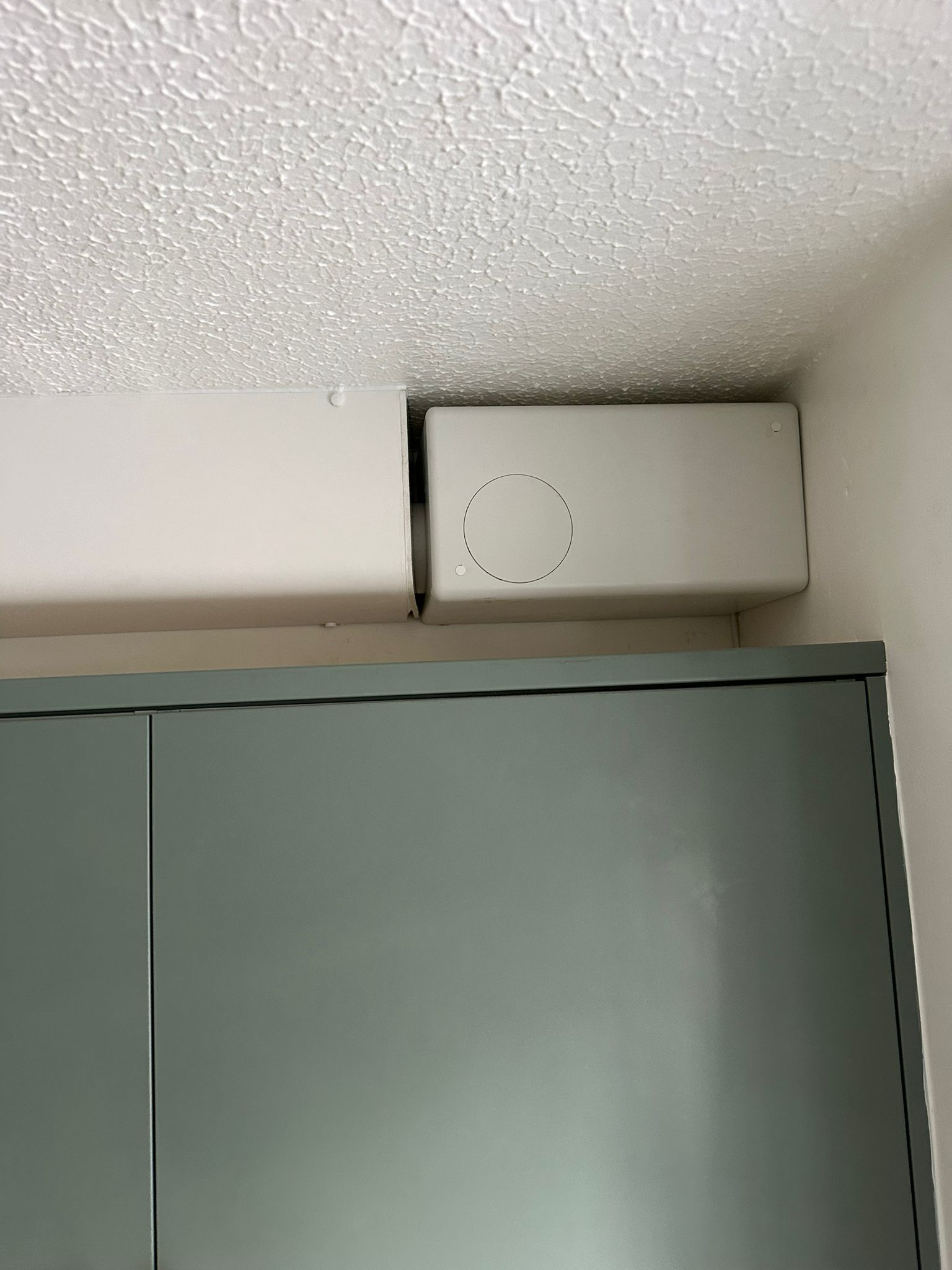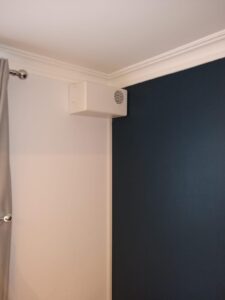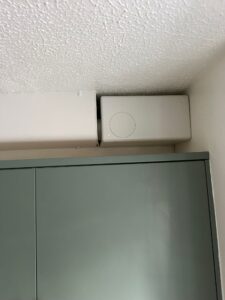
Positive Input Ventilation (PIV) System Installation
Improve Air Quality | Eliminate Damp | Reduce Mould
Serving homes across London & the South East
Struggling With Damp, Condensation or Mould?
If your home constantly feels damp, your windows fog up in the mornings, or black mould patches keep returning no matter how often you clean – it’s time to look at a long-term solution. A Positive Input Ventilation (PIV) system is a highly effective way to reduce indoor humidity and prevent condensation, damp, and mould problems from recurring. At Damp and Mould Solutions Ltd, we supply and install PIV systems tailored to your property type – whether you're in a flat, a terraced house, or a large family home.What Is a PIV System?
A Positive Input Ventilation system works by introducing a continuous, gentle flow of filtered fresh air into your home – usually from the loft (in houses) or via a wall-mounted unit (in flats). This fresh air replaces damp, stale air and helps push out excess humidity. This improves indoor air quality while reducing condensation and black mould, particularly on cold surfaces like windows, walls, and ceilings.
Key Benefits of a PIV Ventilation System
✅ Reduces Damp & Mould
Stops condensation from settling on surfaces – preventing black mould, peeling paint, and warped wood.
✅ Cleaner, Fresher Air
Improves air quality by filtering out pollutants, allergens, and odours – great for asthma and allergy sufferers.
✅ Low Running Costs
Energy-efficient units use minimal electricity and typically cost just a few pence a day to operate.
✅ Minimal Maintenance
Only occasional filter changes required. No messy upkeep.
✅ Quiet Operation
Modern PIV units are designed to run quietly in the background – most customers barely notice them once installed.

🏠 Loft-Mounted PIV Units (for Houses)
Installed in your loft space, these systems draw in filtered air and distribute it gently throughout your home. Some models come with built-in heaters to warm incoming air during colder months.

🏢 Wall-Mounted PIV Units (for Flats & Homes Without Lofts)
Ideal for apartments and ground-floor flats, these units are installed on internal walls and still provide excellent airflow and damp prevention in enclosed spaces.

Licence & Insured
Nemo enim ipsam voluptatem quia voluptas sit aspernaturip-sam voluptatem quia.
Professional Installation Across London
All PIV systems should be installed by a qualified professional to ensure safe and optimal performance. Our certified engineers carry out each installation to high standards, with minimal disruption to your home. What to Expect After Installation Most homeowners see noticeable changes within a few days to weeks: Less condensation on windows Fresher, less musty-smelling air Reduction in damp spots and mould patches No more wiping windows every morning Your PIV system will continue working in the background, keeping your home healthy and dry all year round.
We cover all major London boroughs and surrounding areas.
Things to Consider:
-
Upfront Investment: There is an initial cost for supply and installation, but it pays for itself by preventing costly damp damage and redecorating.
-
Air Circulation: For best results, ensure air can flow between rooms. We may recommend undercutting doors slightly to help.
- Winter Heating: Incoming air may feel cooler in winter, but many units come with heating elements to reduce this.
Is your home struggling with condensation, damp, or poor indoor air quality? Damp and Mould Solutions Ltd. is here to help! Our expert team provides tailored ventilation and damp-proofing solutions to keep your home fresh, dry, and healthy.
Take the first step towards a healthier home today!
📞 Call us on 020 4542 6114 to book your free ventilation survey.
📧 Email us at info@dampandmouldsolutions.co.uk
Reminder: Condensation is a common problem in the UK, affecting around one in five homes. While most people are familiar with condensation, understanding its cause and how to address it is essential.
A Fresh Solution to Damp and Mould
Struggling with constant condensation or the growth of black mould in your home? A Positive Input Ventilation (PIV) system, also known as Positive Input Ventilation (PIV), could be the key to resolving these persistent issues. PIV units are designed to enhance airflow throughout your property, introducing a steady stream of clean, fresh air while expelling humid, stagnant air. By improving air circulation, these systems not only help eliminate condensation but also significantly enhance overall indoor air quality, reducing the risk of damp and mould formation.
How Positive Input Ventilation Operates
PIV systems work by gently pressurising your property and boosting air movement across rooms. This process involves drawing fresh air from outside, then displacing moist air trapped indoors. By addressing condensation at its source, PPV units actively reduce the likelihood of mould growth and structural dampness, leaving your home healthier and free from moisture-related problems.
Benefits of PositiveInput Ventilation Systems
Installing a PPV system in your home provides numerous advantages, including:
- Low energy consumption: These systems are designed to be efficient, keeping running costs low.
- Quiet operation: Advanced engineering ensures that PPV units operate quietly, making them unobtrusive.
- Allergy relief: Fresh, filtered air helps reduce allergens and pollutants, improving comfort for allergy sufferers.
- Whole-home air ventilation: PPV systems maintain a consistent flow of clean air throughout your entire property, from living rooms to bedrooms.
Say goodbye to:
- Peeling wallpaper and damaged paint
- Black mould outbreaks
- Musty odours
- Stale, stagnant air
Positiv Input Systems for Homes and Flats
At Damp and Mould Solutions, we provide PPV systems for all property types—whether you live in a house with a loft or a flat without one.
PIV Loft Systems
For homes with a loft space, a PIV loft system is an ideal solution. These units draw fresh air from outside and distribute it throughout your home from a concealed unit located in your loft. With multiple running speeds and automatic adjustments based on the number of rooms, the system ensures optimal air circulation. Some models even include a heater to warm the incoming air during colder months, improving comfort without compromising air quality.
Positive Input Systems for Flats
If your flat or apartment has no loft space, a wall-mounted PPV unit can still address your condensation issues. Installed in strategic locations like hallways or landings, these systems introduce filtered, fresh air while driving out stagnant, humid air. Some models also include built-in heaters and automatic airflow adjustment features for maximum efficiency.
Installation of Positive Input Ventilation Units
For the best results, PPV systems should be installed by a certified electrician, ensuring compliance with the manufacturer’s specifications. The units are designed to be adaptable and simple to install, making them a flexible solution for both houses and flats.
The operation of a Positive Input Ventilation system (PIV) system follows these key processes:
- Ingesting external air: A device, typically positioned in the attic space, draws in external air from the surrounding environment.
- Purifying the air: The incoming air undergoes filtration, stripping away contaminants such as pollen, vehicular exhaust, and other airborne impurities.
- Dispersing the air: Once filtered, the air is gently diffused at ceiling height, which establishes a positive pressure within the building.
- Expelling stagnant air: This positive pressure pushes stale air out of the property through natural gaps like window crevices or poorly sealed openings in the building’s structure.
- Elevating air purity: As fresh air circulates, it displaces stale air and indoor contaminants, including harmful substances like carbon dioxide.
- Diminishing condensation: The replacement of moisture-laden air with fresh, drier air reduces condensation on windows and other cool surfaces, curbing excess humidity.
- Inhibiting mold formation: By removing excess moisture and pollutants, PIV systems effectively thwart mold growth and the associated damage it can cause.
However, there are several considerations to bear in mind when employing a PIV system:
- Filter upkeep: Filters must be changed periodically to avoid restricted airflow or the potential for mold to develop within the system.
- Sealing of interior doors: Internal doors should not be sealed too tightly, as this may hinder proper airflow throughout the home.
- Building configuration: Certain architectural layouts, especially those that are elongated or overly complex, might not be well-suited for PIV systems.
- Professional installation: PIV units should be installed by a certified electrician, adhering closely to the manufacturer’s guidelines for optimal performance.
By considering these aspects, homeowners can ensure their PIV system operates efficiently, providing a healthier and more comfortable living environment.
Positive Input Ventilation (PIV) systems come with a range of benefits and drawbacks, which include:
Advantages:
- Energy efficiency: Contemporary PIV units are designed to be highly energy-efficient, operating with minimal energy consumption and offering low ongoing costs.
- Ease of installation: Installing a PIV system is generally quick and cost-effective, making it an attractive option for homeowners.
- Minimal upkeep: PIV systems demand little in terms of maintenance or supervision, providing a “set-it-and-forget-it” convenience.
- Enhanced air quality: By continuously introducing filtered air, PIV units help reduce indoor allergens such as dust mites, pollen, and other irritants.
- Reduction in humidity: These systems can significantly lower indoor humidity levels, creating a less hospitable environment for dust mites and reducing moisture-related issues.
Disadvantages:
- Initial investment: There is an upfront cost associated with purchasing and installing the system.
- Possible increase in heating costs: Since PIV units introduce air from outside, there may be a slight rise in heating bills, especially in colder climates.
- Not universally applicable: PIV systems are most effective in homes with a high degree of natural air leakage. Properties with better insulation or more airtight structures may not benefit as much.
- Potential drafts: The circulation of outside air may cause drafts, which could be uncomfortable in certain areas of the home.
- Climate limitations: PIV systems may not be as effective in extremely humid or arid climates, where outside air conditions are less favorable.
Selecting the ideal ventilation system depends on both your comfort preferences and the specific characteristics of your home. It is advisable to consult with a professional HVAC technician who can assess your needs and recommend the most suitable solution for your living space.
If you have any questions regarding Positive Input Ventilation systems or how to control condensation, feel free to reach out to our technical experts at 020 4542 6114. We’re here to guide you to the right solution for your property’s needs.
FAQs: Positive Input Ventilation Systems
1. What is Positive Input Ventilation (PIV)?
Positive Input Ventilation (PIV) is a system, also known as Positive Input Ventilation (PIV), that delivers air into a space or directly into the lungs by creating a flow of air at higher pressure than the surrounding environment. It is used in medical settings to assist patients with breathing and in homes to improve air circulation and reduce condensation.
2. How does Positive Input Ventilation work in homes?
In homes, PPV systems draw in fresh air from the outside and pressurise it into the property. This fresh air pushes out stale, moist air, reducing condensation and mould. It improves overall indoor air quality, helping maintain a healthier living environment.
3. What are the types of Positive Input Ventilation in medical settings?
There are two main types:
- Non-invasive Positive Input Ventilation (NIPIV): This involves using a tight-fitting mask to deliver air into the lungs without the need for a tube. It is suitable for patients who are breathing on their own but require additional respiratory support.
- Invasive Positive Input Ventilation (IPIV): This method uses a tube inserted into the airway, either through the mouth or neck, connected to a ventilator. It is used for more critical cases where full respiratory support is required.
4. Where is PIV used in medical settings?
- Operating Rooms: PIV was originally used here to help patients maintain proper oxygenation during surgery.
- Intensive Care Units (ICUs): Invasive PPV is often used in ICUs to support patients with severe respiratory issues. Non-invasive PPV can be used for less severe cases to avoid the risks associated with invasive procedures.
5. What are the benefits of Positive Input Ventilation systems for homes?
PIV systems offer several benefits, including:
- Reducing condensation and preventing the growth of mould.
- Improving air quality by removing stale, humid air.
- Providing whole-home ventilation, ensuring fresh air flows through all rooms.
- Some units feature automatic adjustments to optimise airflow based on room size.
6. What types of Positive Input Ventilation systems are available for homes?
There are two main types of PIV systems for homes:
- Loft-based PIV Systems: Installed in houses with lofts, these systems draw in fresh air from outside and distribute it throughout the home. Many models include heaters to warm the incoming air in colder months.
- Wall-mounted PIV Systems: Ideal for flats or homes without lofts, these units are installed on walls and operate similarly by expelling moist, stagnant air and bringing in filtered, fresh air.
7. Can Positive Input Ventilation systems help with allergies?
Yes, PIV systems improve indoor air quality by continuously filtering and introducing fresh air, which can help reduce allergens, dust, and other pollutants. This makes the environment more comfortable for those suffering from respiratory issues or allergies.
8. Are Positive Input Ventilation systems noisy?
Most modern PIV systems are designed to operate quietly. They are engineered to be efficient without causing noise disturbances, ensuring they run unobtrusively in your home.
9. Who should install a Positive Input Ventilation system?
PIV systems should be installed by a qualified electrician or professional, following the manufacturer’s guidelines. Proper installation ensures the system operates efficiently and safely.
10. How does Positive Input Ventilation help prevent mould?
By continuously circulating fresh air and expelling humid, stagnant air, PIV systems reduce the conditions where mould thrives. This keeps walls, ceilings, and other surfaces free from excess moisture, preventing mould growth.
For further questions or to find the best PIV solution for your home, contact our experts at 020 4542 6114.




